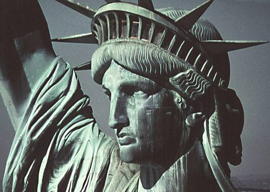
November 03, 2011

The Radical Republicans, who were then running French national politics, did not go to other continents to enslave their inhabitants. Or that’s not what the French foreign minister Jules Ferry and his fellow imperialists claimed to be doing. They were occupying Indochina and Central Africa to bring other continents’ benighted people the gift of democratic freedom. It was inconsistent in their eyes to advocate universal rights for Frenchmen without carrying those blessings elsewhere—with sufficient military personnel. Sounds familiar!
At the time, the French right opposed foreign adventures. The French left were the ones who advocated imperialism as part of their Jacobin legacy. Occupying faraway places was an extension of what Robespierre and his friends had begun in 1793 by invading and “liberating” France’s neighbors. Neither the French revolutionaries nor their Radical Republican admirers in the 1870s and 1880s had the slightest interest in extending the vote to women. It was the socialists, eccentric spinsters, and American Methodists who took up that cause.
I harbor (pardon the pun!) no ill will toward Bartholdi or his creation in New York Harbor. Some of my fondest childhood memories involve Bartholdi’s statue, celebrating the supposedly shared legacy of liberty belonging to Americans and Frenchmen.
My father used to drive me and my brother from our Connecticut home to Lady Liberty (which back then took several hours of travel, including the ferry trip) to show me what he beheld as he entered New York City while escaping the impending storm in his European homeland. I associated the statue with my family’s history. Neither the cult of Ellis Island nor the “huddled masses” theme contributed to my affection for this wrought-iron tribute to “Liberty Enlightening the World.” It was rather that towering object my father and, later, his relatives saw as they reached the New World after leaving Cherbourg and spending about ten days on sea. It signified the safety they were hoping to find in their chosen place of refuge.
But modern journalists and academics tend to judge past figures by modern standards. Why is the cultural and social revolution that began in this country in the 1960s supposed to furnish the criteria for assessing the rest of human history? Why is it no longer possible to say that in the past people had one concept of “liberty” or “rights” while our age is promoting another one? Why is any political conception that fails to conform to our fashions a sign of “serious flaws”?
Today’s intellectuals are so driven by their selective moral passions that they can’t leave them out of anything they’re investigating. As soon as they launch a discourse, up pop their fixations. A comment about the Statue of Liberty therefore cannot be purely descriptive; it must also be an occasion to dwell on how far we’ve come in lifting certain minorities toward equality and how far we have yet to travel before realizing this ideal fully. Even past radicals were not radical enough to meet contemporary standards; when speaking about French Radical Republicans or Irish Catholic American mayors of the 1880s, an accredited intellectual is expected to stress past figures’ failure to be as good as we are. Professor Golway’s sermonette illustrates what today passes for higher morality. It is moral arrogance pretending to be scholarship.